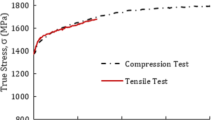Abstract
The critical strain, after which the flow stress almost remains constant, was investigated in the dynamic material properties test of Al7050-T7451. So, the strain cut-off value was introduced into the power-law material model to prevent the large extrapolation errors at strains that were higher than tested. Turning experiments considering the different rake angles, feed rates, and cutting speeds were performed. The turning forces and chip thickness were measured. Turning processes with different strain cut-off values were simulated by the aid of finite element method software AdvantEdge. The simulated turning forces and chip thickness were extracted. The strain cut-off value was determined by the comparison of experimental and simulated results, 0.3 in this case. Simulated results showed good agreement with the experimental results.
Similar content being viewed by others
References
Hopkinson B (1914) A method of measuring the pressure produced in the detonation of high explosive or by the impact of bullets. Philos Trans R Soc Lond Ser A 213:437–456
Kolsky H (1994) An investigation of the mechanical properties of materials very high rates of loading. Proc Phys Soc (London) B63:676–700
Davies EDH, Hunter SC (1963) The dynamic compression testing of solids by the method of the split Hopkinson pressure bar. J Mech Phys Solids 11:155–179
Lindholm US (1964) Some experiments with the split Hopkinson pressure bar. J Mech Phys Solids 12:317–335
Chiddister JL, Malvern LE (1963) Compression-impact testing of aluminum at elevated temperature. Exp Mech 3:81–90
Lankford J (1981) Temperature-strain rate dependence of compressive strength and damage mechanisms in aluminum oxide. J Mater Sci 16:1567–1578
Lee WS, Lin CF (1998) High-temperature deformation behavior of Ti6Al4V alloy evaluated by high strain-rate compression tests. J Mater Process Technol 75:127–136
Lee WS, Yeh GW (1997) The plastic deformation behavior of AISI 4340 alloy steel subjected to high temperature and high strain rate loading conditions. J Mater Process Technol 71:224–234
Lennon AM, Ramesh KT (1998) A technique for measuring the dynamic behavior of materials at high temperatures. Int J Plast 14(12):1279–1292
Oxley PLB (1989) Mechanics of machining, an analytical approach to assessing machinability. Ellis Horwood Limited, Chichester
Movahhedy GMS, Altintas Y (2000) Simulation of orthogonal metal cutting process using arbitrary Lagrangian-Eulerian finite element method. J Mater Process Technol 103:267–275
Movahhedy MR, Altintas Y, Gadala MS (2002) Numerical analysis of metal cutting with chamfered and blunt tools. J Manuf Sci Eng 124:178–188
Sasso M, Newaz G, Amodio D (2008) Material characterization at high strain rate by Hopkinson bar tests and finite element optimization. Mater Sci Eng A 487:289–300
Cheng QL (2006) Study on numerical simulation and experiment of machining process for aerospace monolithic components (in Chinese), doctor dissertation. Zhejiang University, Hangzhou
Gao YH (1994) Dynamic compression and tensile properties of Al alloys Lc4 and LY12cz at high strain rate (in Chinese). Mater Sci Technol 2:24–29
Gao YH (1995) An experimental study of rate-dependence materials Al-alloys Lc4 and LY12cz (in Chinese). Chin Quart Mech 16:61–66
Peng K, Chen W, Qian K (2006) Study on dynamic strain aging phenomenon of 3004 aluminum alloy. Mater Sci Eng A 415:53–58
Guo WG, Tian HW (2009) Strain rate sensitivity and constitutive models of several typical aluminum alloys (in Chinese). Chin J Nonferrous Met 19:56–61
Seo S, Min O, Yang H (2005) Constitutive equation for Ti-6Al-4 V at high temperatures measured using the SHPB technique. Int J Impact Eng 31:735–754
Fu XL (2007) Research on deformation theory and characteristics of machined surface for high-speed milling aviation aluminum alloy (in Chinese), doctor dissertation. Shandong University, Jinan
Marusich TD, Ortiz M (1995) Modeling and simulation of high-speed machining. Int J Numer Methods Eng 38:3675–3694
Shatla M, Kerk C, Altan T (2001) Process modeling in machining. Part I: determination of flow stress data. Int J Mach Tools Manuf 41:1511–1534
Bil H, Kιlιç SE, Tekkaya AE (2004) A comparison of orthogonal cutting data from experiments with three different finite element models. Int J Mach Tools Manuf 44:933–944
Yen Y, Jain A, Altan T (2004) A finite element analysis of orthogonal machining using different tool edge geometries. J Mater Process Technol 146:72–81
Wang ZQ, Sun J, Li JF, et al (2007) Prediction of residual stress in hard turning of AISI 52100 using 2D FEM. 6th International Conference on e-Engineering and Digital Enterprise Technology, pp 688–691
Author information
Authors and Affiliations
Corresponding author
Additional information
An erratum to this article can be found at http://dx.doi.org/10.1007/s00170-009-2442-8
Rights and permissions
About this article
Cite this article
Jiang, F., Li, J., Sun, J. et al. Al7050-T7451 turning simulation based on the modified power-law material model. Int J Adv Manuf Technol 48, 871–880 (2010). https://doi.org/10.1007/s00170-009-2328-9
Received:
Accepted:
Published:
Issue Date:
DOI: https://doi.org/10.1007/s00170-009-2328-9



